Marshalling
WARNING: Do not cite this page as a reference. This page is on this wikispace only to make the content "searchable" and easier to find. If you find the information you seek here, go to the original sources as linked below to verify the information and use them for your documentation.
Hints for reading SENA A.6.F. Claims through Marshalling:[edit | edit source]
- Read SENA A6F as a straight-through run.
- As soon you hit a "has appearance of marshalling" in A6F2 or A6F3, you can stop checking, because it has the appearance of marshalling and isn't registerable.
- If you don't hit a "has appearance of marshalling" by the time you reach the end, you're good.
- A6F1 is "things that are not marshalling",
- A6F2 is "things that are marshalling" and
- A6F3 is "things that may or may not be marshalling" -- and note that it starts with the phrase "Designs which do not fit into section 1 or 2 above must be considered more carefully."
- If your design fit into section 2 already, then it's marshalling, and you don't need to bother with section 3 at all.
-per Emma Wreath Emeritus and Marie de Blois Palimpsest Emeritus
SENA A.6. Presumption[edit | edit source]
http://heraldry.sca.org/laurel/sena.html#A6
F. Claims through Marshalling: Marshalling is the combination of two or more arms into a single design. By doing so, it makes a claim about the person that we do not allow in registered arms. This claim can be to a marital or inheritance relationship or about an office that the person holds. In some cases, such designs may be displayed, even though they cannot be registered. Arms combined using the per pale field division generally combined either marital arms or the arms of an individual and an office. They are often called impaled arms and were not inherited. The display of registered arms impaled to show a marital relationship is encouraged, even though it is not registerable.
Arms combined using the quarterly field division generally combined inherited arms from armigerous parents. They are often called marshalled arms or quartered arms. Once inherited, they were sometimes further cadenced as a whole. While the Spanish occasionally used per saltire divisions for marshalled designs, they more commonly used quarterly divisions for this, so we do not consider fields divided per saltire as potentially marshalled designs.
Marshalling in these rules refers to both impaling and quartering collectively. Arms which appear to be marshalled cannot be registered. Both quarterly and per pale divisions were used in single armorial designs and also in marshalled designs. Therefore, quarterly and per pale divisions of the field may be registered only when there is no unmistakable appearance of marshalling. Most designs are either clearly not marshalled or clearly marshalled, but some require more careful examination:
- 1. Designs which do Not Create the Appearance of Marshalling: A design with one of these features is not marshalled.
- a. Plain Field or Other Field Division: Only designs with per pale and quarterly field divisions are potentially marshalled. Designs with another field division or no field division are not marshalled under these rules.
- b. Complex Lines of Division: As marshalling was only used with plain line divisions, the use of a complex line of division with a quarterly or per pale field division does not create the appearance of marshalling.
For example, Per pale azure and Or, a talbot and a hart rampant addorsed has the appearance of marshalling. However, Per pale raguly azure and Or, a talbot and a hart rampant addorsed does not.
- c. Single Primary Charge Group Over The Entire Field: A design that contains only a primary charge group of certain kinds does not have the appearance of marshalling. The primary charge group must be one of: semy of identical charges over the entire field, a single identical charge in each charged section, a group of multiple identical charges in a standard arrangement covering the entire field, or a single standard arrangement of multiple primary charges with at least one charge crossing the per pale line of division. Special rules affect designs with peripheral ordinaries and quarterly field divisions with primary ordinaries like crosses; they are discussed in section 3 (A.6.F.3) below.
For example, Per pale azure and argent all semy of cinquefoils counterchanged does not have the appearance of marshalling. Quarterly gules and Or, four crescents counterchanged argent and sable does not have the appearance of marshalling. Per pale gules and sable, six cauldrons two, two and two argent does not have the appearance of marshalling. Quarterly vair and Or, three crosses moline gules does not have the appearance of marshalling. All of these are registerable.
- 2. Designs which Create the Appearance of Marshalling: In general, when any section of the field can only be understood as an independent piece of armory, it creates the unmistakable appearance of marshalling.
- a. Charges which Terminate at the Edge of a Section: When a charge or charges terminate at the edge of a section, it creates the unmistakable appearance of marshalling. This most commonly occurs with ordinaries. This includes both the situation where a field division appears to be multiple ordinaries and the situation where multiple ordinaries appear to be a field division. [also includes dimidation? see image below]
For example, Quarterly gules and chevronelly argent and azure creates the appearance of marshalling and is not registerable.
- b. Sections which are Subdivided: A section of the field which is divided further into multiple parts generally creates the unmistakable appearance of marshalling. Such designs can only be registered when it is demonstrated to have been used in similar designs which are not marshalled.
For example, Per pale gules and quarterly argent and azure, a heart argent has the appearance of marshalling and cannot be registered. However, checky is found in quarters of armory that is not marshalled. Thus, Quarterly gules and checky argent and azure, a heart argent does not have the appearance of marshalling.
- c. Multiple Types of Primary Charges: When different sections of the field contain different types of charges, it creates the appearance of marshalling.
For example, Quarterly gules and azure, in bend two crosses crosslet and in bend sinister two roses argent creates the appearance of marshalling, as does Quarterly vert and erminois, in bend a badger and a fleur-de-lys argent. Per pale argent and sable, a unicorn sable and a dragon Or combatant creates the appearance of marshalling. In each case, the different types of charges create the appearance of marshalling.
- d. Multiple Charges in a Section: When any section of such a field contains multiple charges of the same type in a way that cannot be described as a standard single pattern covering the entire field, multiple charges of different types, or multiple charge groups, it creates the appearance of marshalling. For example, Quarterly azure and Or, in canton three crosses fleury argent creates the appearance of marshalling, because the charges cannot be blazoned as a single pattern covering the entire field. Similarly, Per pale sable and erminois, each section charged with three billets two and one counterchangedcreates the appearance of marshalling, because each section appears to be an independent piece of armory. However, Per pale sable and erminois, six billets two, two, and two counterchanged does not create the appearance of marshalling, because the arrangement of all the charges can be blazoned as a single coherent pattern. For example, Quarterly sable and Or, in canton a lion and a unicorn combattant Or creates the appearance of marshalling because a single section of the field contains multiple types of charges. Similarly, Per pale gules and argent, a tree and in chief a mullet gules creates the appearance of marshalling because the tree and mullet are forced into the argent section of the field and thus it contains multiple charge groups.
[Updated per April 2013 Cover Letter - http://heraldry.sca.org/loar/2013/04/13-04cl.html ]
- 3. Designs which May or May Not Create the Appearance of Marshalling: Designs which do not fit into section 1 or 2 above must be considered more carefully.
- a. Plain Sections Without Charges: When each section of the design appears to be an independent coat of arms, it creates the unmistakable appearance of marshalling. A section of the design does not appear to be an independent coat of arms if it is a plain tincture, including a fur, which we do not protect as arms.
As the protected arms of Brittany are Ermine, the use of an uncharged ermine section or sections when combined with a charged section creates the appearance of marshalling. However, since flags would not be used as part of quartered arms, the use of an uncharged vert section or sections does not create the appearance of marshalling, even though we protect the flag of Libya as Vert.
For example, Per pale ermine and gules, a leopard's face argent has the appearance of marshalling, but Per pale argent and gules, a leopard's face argent does not. Quarterly azure and ermine, two maunches argent has the appearance of marshalling, but Quarterly azure and argent, two maunches argent does not.
- b. Quarterly Fields with Multiple Charge Groups: In many cases, a design with a charge or charges that cross the quarterly lines of division does not create the appearance of marshalling.
For example, Quarterly azure and erminois, a gauntlet sable between two annulets azure does not have the appearance of marshalling, as the primary gauntlet is partially in all four quarters. Similarly, Quarterly azure and erminois, a bend argent between two annulets azure does not have the appearance of marshalling, as the bend is partially in all four quarters. For example, Quarterly Or and vert semy-de-lys Or, two millrinds vert, a chief gules does not have the appearance of marshalling.
However, marshalling using a quarterly line of division was inherited. Once inherited, the quartered arms might be further cadenced with added bordures, labels, or other charges used for cadency in period. Therefore, adding those charges does not remove the appearance of marshalling for armorial designs with a quarterly line of division. Crosses throughout were also added to marshalled designs, so the addition of a cross throughout that overlies a quarterly field does not remove the appearance of marshalling.
For example, Quarterly ermine and gules, in bend two salamanders gules and in bend sinister two open books Or and in chief a label sable has the appearance of marshalling; the label does not remove this appearance. Quarterly azure and Or, a cross between in bend two millrinds and in bend sinister two annulets counterchanged has the appearance of marshalling; the cross does not remove this appearance.
- c. Per Pale Fields with Multiple Charge Groups: As marshalled arms using a per pale line of division were not inherited, the addition of a charge or charge group which crosses the per pale line is generally sufficient to remove the unmistakable appearance that a portion of the field is independent armory. The addition of a bordure or chief that does not itself appear to be part of two distinct original arms also removes that appearance. In general, a chief or bordure which has poor contrast with one side of the field or one that is charged so that identical charges or parts of charges appear on both sides of the line of division or bordure meets this standard.
For example, Per pale gules and ermine, a boar's head and a eagle displayed counterchanged, a chief azure does not have the appearance of marshalling. Per pale vert and Or, a billet and a sun counterchanged, in chief a label argent does not have the appearance of marshalling, because the label crosses the per pale line. The label cannot be unmistakably seen as a mark of cadency, since impaled armory was not inherited.
On the other hand, in Per pale purpure and Or, a chief per pale argent and sable the chief divided per pale creates the appearance of marshalling Purpure, a chief argent with Or, a chief sable. For example, in Per pale Or and sable, a lozenge and a roundel counterchanged and on a chief argent a hare and a fox sable, the dissimilar charges on the chief create the appearance of marshalling. However, Per pale Or and sable, a lozenge and a roundel counterchanged and on a chief argent a hare between two foxes sable does not create the appearance of marshalling, because the hare crosses the center line. Similarly, same armory with two hares or with two foxes on the chief would also not create the appearance of marshalling.
See also "Avoiding the Appearance of Marshalling" - http://coblaith.net/Heraldry/Marshalling/default.html
Marshalling in Heraldry Article[edit | edit source]
http://www.modaruniversity.org/marshalling.htm (based on the old Rules for Submission, but basic principles still hold under SENA)
Marshalling is a style of heraldic design to show familial relationships or alliances. While such was done in the middle ages, it is not registerable in the SCA. To assist folks in understanding what is and what is not considered marshalling, presented here are some guidelines and some pictorial examples:
Guidelines:
| 1. | A field divided per pale with different charges in each half of the field is not allowed, if there is a plain (straight) line of division. If the per pale line is a complex (fancy) line, then it is allowed. | 
|

|
| 2. | A field divided per pale with the same charge in each half of the field is allowed, even if the line of division is a plain (straight) line. | 
| |
| 3. | A field divided quarterly with one type of charge in the top left and bottom right quarters and a different type of charge in the top right and the bottom left quarters is not allowed if the lines dividing the field into quarters is a plain (straight) line of division.
If either the per pale line or the per fess line is a complex (fancy) line, or both the per pale and per fess line is a complex (fancy) line, then it is not considered marshalling...but doing this may create poor style <which could cause a return for non-period style>, so consider such a design carefully . |

|

|
| 4. | A field divided quarterly with a different charge in each of the four sections is considered both marshalled arms and to be "slot machine heraldry". | 
| |
| 5. | A field divided quarterly with one (same) type of charge in the top left and bottom right quarters and just a tincture (no charges) in the top right and the bottom left quarters is allowed, even if the lines of division are plain (straight) lines.
A field divided quarterly with one (same) type of charge in the top right and bottom left quarters and just a tincture (no charges) in the top left and the bottom right quarters is allowed, even if the lines of division are plain (straight) lines. |
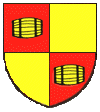
|
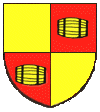
|
| 6. | A field divided quarterly with different types of charge in the top left and bottom right quarters and just a tincture (no charges) in the top right and the bottom left quarters is considered marshalled arms.
A field divided quarterly with different types of charge in the top right and bottom left quarters and just a tincture (no charges) in the top left and the bottom right quarters is considered marshalled arms. |
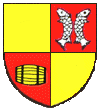
|
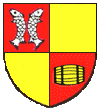
|
Review of Visual Examples:

|

|

|

|

| |
| Marshalling | Not Marshalling | Not Marshalling | Marshalling | Not Marshalling | |

|

|

|

|

|
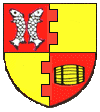
|
| Marshalling, Slot Machine | Not Marshalling | Not Marshalling | Marshalling | Marshalling | Not Marshalling |
| [Per last line of RfS XI.3]. | [Per last line of RfS XI.3]. |
Marshalling for Display Purposes
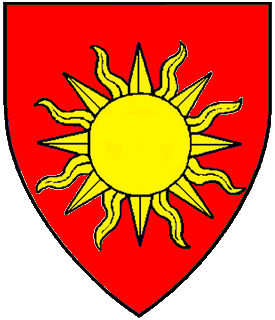
|
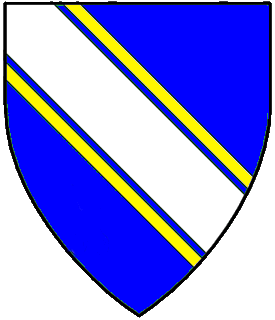
| |
| Original Device #1 | Original Device #2 | |
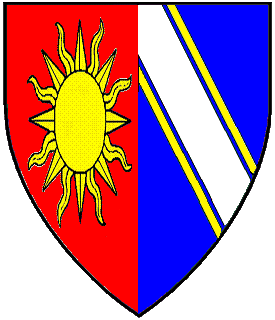
|
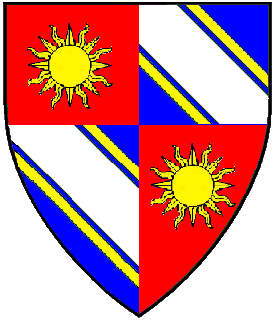
|
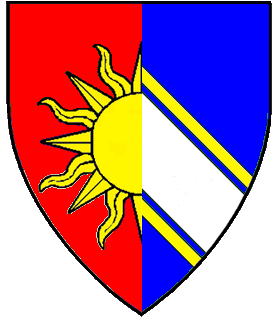
|
| Marshalling Per Pale | Marshalling Quarterly | Marshalling by Dimidiation |
NOTE: Armory designs that appear to marshall independent arms are considered presumptuous and cannot be registered (as per RfS Part XI.3, Presumptuous Armory.
HOWEVER...display of such shows allegiance or marriage and is allowed (and encouraged) in the SCA.
Precedents:[edit | edit source]
April 2013 Cover Letter - Closing a Loophole in the Marshalling Rules[edit | edit source]
On the November 2012 LoAR Cover Letter, Wreath noted that the marshalling rules in SENA do not address designs in which one section of the field has multiple charge groups. This was not intended. Not long after, Palimpsest issued a Rules Letter with a proposed change to SENA section A.6.F.2.d to address this. To close this loophole and disallow designs in which any section of the field has multiple charge groups, we are changing A.6.F.2.d., effective immediately, to read: d. Multiple Charges in a Section: When any section of such a field contains multiple charges of the same type in a way that cannot be described as a standard single pattern covering the entire field, multiple charges of different types, or multiple charge groups, it creates the appearance of marshalling. http://heraldry.sca.org/loar/2013/04/13-04cl.html
November 2012 Cover Letter - Marshalling Loophole[edit | edit source]
A submission this month was ruled to not be in violation of the prohibition on marshalling by impaling. The design in question had two charge groups in one section of the field, and nothing in the other section of the field. Under the Rules for Submission, this was illegal: "No section of the field may contain...more than one charge unless those charges are part of a group...." Precedent set on the December 2007 Cover Letter did allow for maintained charges in a section, but not sustained charges.
However, while section A6F of the Standards for Evaluation, which governs marshalling, is far more detailed than the Rules for Submissions were, it does currently allow for designs in which one section of the field has multiple charge groups. A6F2c concerns multiple types of primary charges, but not multiple charge groups in a single section. A6F2d concerns multiple charges in a section, but specifies only multiple charges of the same type, not multiple charge groups.
Palimpsest will be issuing a rules letter in the near future to address changing A6F2d to include a prohibition on multiple charge groups in a section. http://heraldry.sca.org/loar/2012/11/12-11cl.html
March 1994 LoAR - cross couped not the same as cross throughout in marshalling[edit | edit source]
[Registering Quarterly azure and argent, a cross couped between in bend two towers and in bend sinister two roses all counterchanged.] "This comes perilously close to having the appearance of marshalled arms. The fact that the cross here is used as a charge rather than the default cross throughout (which is considered an ordinary) saves it from falling afoul of XI.3. No evidence was found by any of the commenters that crosses couped were used in the same way as crosses throughout, crosses paty throughout, or crosses engrailed throughout were in marshalled arms." March 1994 LoAR
November 1991 - cross throughout does NOT overcome appearance of marshalling[edit | edit source]
There are precedents which note that, since crosses were used with quartered (marshaled) arms in period, the addition of a cross overall does _not_ overcome the appearance of marshalling. [Quarterly gules and argent, in bend two <As> argent and in bend sinister two <Bs> vert, overall a cross sable] "Given that crosses overall were not infrequently used in marshalled arms in period, this has every appearance of the marshalled arms of [Gules, an <A> argent, and Argent, a vert]." [The submission was returned for this reason.] November 1991 LoAR.